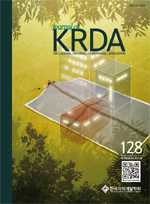학술논문
산촌의 입지 유형에 따른 사회경제적 변화
이용수 19
- 영문명
- Socioeconomic Changes by the Location Type of Mountainous Areas:Focusing Population and Industry
- 발행기관
- 한국지역개발학회
- 저자명
- 박소희(So Hee Park) 장주연(Chu Youn Chang) 민지애(Jee Ae Min)
- 간행물 정보
- 『한국지역개발학회지』제35권 제5호, 63~82쪽, 전체 20쪽
- 주제분류
- 사회과학 > 지역학
- 파일형태
- 발행일자
- 2023.12.31
5,200원
구매일시로부터 72시간 이내에 다운로드 가능합니다.
이 학술논문 정보는 (주)교보문고와 각 발행기관 사이에 저작물 이용 계약이 체결된 것으로, 교보문고를 통해 제공되고 있습니다.

국문 초록
산림기본법에 따르면, 산촌은 산림면적의 비율이 70% 이상이고 인구밀도가 전국 농촌(읍면)의 평균 이하이며 경지면적의 비율이 전국 농촌(읍면)의 평균 이하인 읍면을 말한다. 이러한 정의에 부합하는 산촌 읍면은 2014년 기준 466개로 구분되었다. 이 연구의 목적은 입지 특성에 따라 산촌의 유형을 구분하고, 유형별 사회경제적 변화를 분석하는 것이다. 이 연구에서는 섬산촌을 제외한 452개 산촌 읍면을 대상으로 입지특성(산림면적 비율, 경지면적 비율, 평균 표고, 대도시까지의 거리)에 따라 K-평균 군집분석을 실시하여 산촌의 유형을 구분하였으며, 산촌의 유형에 따라 2010년, 2015년, 2020년 산촌의 인구 수, 고령화율, 청년비율, 농가비율, 임가비율, 종사자 수, 산업별 종사자 수의 변화를 분석하였다. 분석 결과, 산촌은 3개(근교, 매개, 원격) 유형으로 구분되었고, 근교 산촌이 200개, 매개 산촌이 169개, 원격 산촌이 83개로 나타났다. 근교 산촌(대도시와의 거리가 가깝고 평균 표고가 낮고 산림비율이 낮고 경지비율이 높은 산촌)의 경우, 읍면 평균 인구수가 2015년에는 감소했다가 2020년 다시 증가하는 추세를 보였으나, 2010~2020년 고령화율이 가장 큰 폭으로 증가하였다. 근교 산촌은 세 유형 중에 농가비율이 가장 높은 유형이며, 2010~2020년 농가비율이 가장 큰 폭으로 감소하였다. 산업 종사자 수는 가장 큰 폭으로 증가하였으며, 산업별로 제조업 종사자 수가 가장 많이 증가하였다. 반면에 원격 산촌(대도시와 거리가 멀고 평균 고도가 높고 산림비율이 높고 경지비율이 낮은 산촌)의 경우, 읍면 평균 인구수가 2015년에 증가했다가 2020년 큰 폭으로 감소하였으며, 2010~2020년 청년비율이 가장 큰 폭으로 감소하였다. 원격 산촌은 세 유형 중에 임가비율이 가장 높은 유형으로, 2010~2020년 임가비율이 가장 큰 폭으로 감소하였다. 원격 산촌에서는 산업별로 숙박 및 음식점업의 종사자 수가 가장 많이 증가하였다. 앞으로 산촌의 인구정책과 산업 및 일자리 정책은 이러한 사회경제적 변화 추세를 고려하여 산촌 유형별로 다르게 접근할 필요가 있다.
영문 초록
According to the Framework Act on Forestry, mountainous areas refer to areas (Eup·Myeon) in which the ratio of forest land area is 70% or more, the population density is below the national average, and the ratio of agricultural land is below the national average of rural areas (Eup·Myeon). As of 2014, 466 Eup·Myeon were included in mountainous areas. The purpose of this study is to classify the types of mountainous areas according to location characteristics and to analyze the socio-economic changes of each type of location in mountainous areas. To classify the type of mountainous areas, K-means cluster analysis was conducted according to location characteristics (forest land ratio, agricultural land ratio, average elevation, distance to large cities) for 452 Eup·Myeon, excluding 14 Eup·Myeon in island. Depending on the type of mountainous areas, population density, aging rate, youth ratio, farm household ratio, forestry household ratio, main industry, number of workers, and number of workers by industry were measured in 2010, 2015, and 2020. As a result, mountainous areas were classified into three types (mountain, intermediate, and rural type), with 83 mountain type Eup·Myeon, 169 intermediate type Eup·Myeon, and 200 rural type Eup·Myeon. Mountain type areas have a low population density, proportion of an aging population, and farm household and a high proportion of the young, forestry household, and workers in lodging and restaurants businesses while rural type areas have a high population density, proportion of an aging population, farm household, and workers in manufacturing businesses and a low proportion of the young and forestry household. From 2010 to 2020, population density, youth ratio, farm household ratio, and forestry household ratio decreased and aging ratio and number of workers increased in all types of mountainous area. In order to maintain the diversity of them, it is necessary to establish policies considering the location characteristics and functions according to the type of mountainous areas.
목차
1. 서 론
2. 이론적 고찰
3. 연구 방법
4. 연구 결과
5. 결 론
참고문헌
키워드
해당간행물 수록 논문
- 한국지역개발학회지 제35권 제5호 목차
- A Place-based Spatial Analysis on the Occurrence and Diffusion of COVID-19: Focused on Seoul’s COVID-19 confirmed people’s visiting places
- 농촌 공적개발원조 프로젝트 평가를 위한 고려 사항
- 조합장 리더십이 주택정비사업 추진과정과 사업성과에 미치는 영향 분석
- 고령인구를 고려한 폭염취약지 공간분석
- 통행목적지의 도시적 특성에 따른 교통에너지 소비량 발생 요인 분석
- 서울시 장애인의 대중교통 이용에 영향을 미치는 도시특성 분석
- 산촌의 입지 유형에 따른 사회경제적 변화
- 인구와 경제를 고려한 도시축소(urban shrinkage) 진단 및 유형별 사회경제적 특성 분석
- 지속가능한 스마트도시의 지속가능성 요소 분석
참고문헌
교보eBook 첫 방문을 환영 합니다!

신규가입 혜택 지급이 완료 되었습니다.
바로 사용 가능한 교보e캐시 1,000원 (유효기간 7일)
지금 바로 교보eBook의 다양한 콘텐츠를 이용해 보세요!






